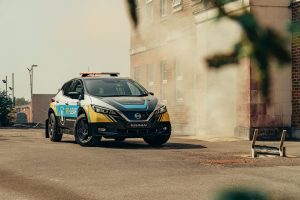NISSAN has unveiled a 100 per cent electric emergency response vehicle concept, designed to provide a mobile power supply following natural disasters or extreme weather events.
Called RE-LEAF, the working prototype is based on the Nissan LEAF passenger car, the world’s first mass-production electric vehicle.
 Alongside modifications to navigate roads covered in debris, the RE-LEAF features weatherproof plug sockets mounted directly to the exterior of the vehicle, which enable 110 to 230-volt devices to be powered from the car’s high-capacity lithium-ion battery.
Alongside modifications to navigate roads covered in debris, the RE-LEAF features weatherproof plug sockets mounted directly to the exterior of the vehicle, which enable 110 to 230-volt devices to be powered from the car’s high-capacity lithium-ion battery.
The RE-LEAF can be driven into the centre of a disaster zone and provide a fully mobile power supply to aid the recovery process. The integrated energy management system can run medical, communications, lighting and other life-supporting equipment.
Real-world applications of EVs during disasters
Natural disasters are the biggest cause of power outages. A 2019 World Bank report found natural shocks and climate change caused 37 per cent of outages in Europe between 2000 and 2017, and 44 per cent of outages in the US over the same period.
 When a disaster hits, the time for electricity supply to be restored is typically 24-48 hours, depending on the severity of the damage. During that period, electric vehicles can provide zero-emission, mobile emergency power.
When a disaster hits, the time for electricity supply to be restored is typically 24-48 hours, depending on the severity of the damage. During that period, electric vehicles can provide zero-emission, mobile emergency power.
Nissan created the RE-LEAF to demonstrate the potential of electric vehicles in disaster recovery. Although it’s just a working concept, the technology is already being used in the real world.
In Japan, Nissan has used the LEAF to provide emergency power and transportation following natural disasters since 2011, and the company has formed partnerships with more than 60 local governments to support disaster relief efforts.
Nissan EVs can also act as mobile storage batteries to supply homes and society with electricity during non-emergency situations, creating a distributable energy model that can be used to help stabilize supply and demand.
 The RE-LEAF uses the LEAF’s bi-directional charging ability, a standard feature of the model since its introduction in 2010.
The RE-LEAF uses the LEAF’s bi-directional charging ability, a standard feature of the model since its introduction in 2010.
This means the LEAF can not only ‘pull’ power to recharge the high-capacity battery, but also ‘push’ it back to the grid through V2G (Vehicle-to-Grid) technology, or directly to electronic devices through V2X (Vehicle-to-everything).
Acting as a portable power station, the latest generation Nissan LEAF e+ with a fully charged 62 kilowatt-hour (kWh) battery can provide enough electricity to power the average UK household for around six days.
Smarter, cleaner technology can help save lives
Helen Perry, Head of Electric Passenger Cars & Infrastructure for Nissan in Europe, commented: ‘Through Nissan Intelligent Mobility, we’re constantly exploring ways that electric vehicles can enrich our lives, beyond just zero-emission transportation. Concepts like the RE-LEAF show the possible application of EVs in disaster management and demonstrate that smarter, cleaner technology can help save lives and provide greater resilience for the future.
 ‘Electric vehicles are emerging as one of the technologies that can improve resilience in the power sector. By having thousands of EVs available on standby, either as disaster-support vehicles or plugged into the network through Vehicle-to-Grid (V2G), they’re uniquely capable of creating a virtual power plant to maintain a supply of energy during a major outage.’
‘Electric vehicles are emerging as one of the technologies that can improve resilience in the power sector. By having thousands of EVs available on standby, either as disaster-support vehicles or plugged into the network through Vehicle-to-Grid (V2G), they’re uniquely capable of creating a virtual power plant to maintain a supply of energy during a major outage.’
Dan Cooke, Operations Director at Serve On, the UK’s leading organisation providing emergency search and rescue in natural disasters around the world, added: “When responding to a disaster, two critical factors that make all the difference are establishing communications, and staying hydrated.
‘Situational awareness saves lives and running a ‘‘command and control’’ centre allows us to get the real picture of what’s happening whilst the infrastructure gets back online, but that needs power. Seeing the RE-LEAF is really exciting, because we love exploring new ideas to see what’s possible. Looking back to previous scenarios we’ve dealt with, this technology could have made a real difference. For example being able to power multiple filtration devices to produce thousands of litres of drinking water – essential in our line of work.’




